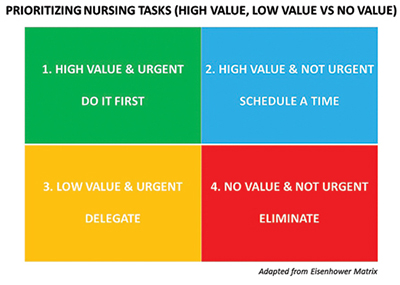
With the recent nursing shortage, nursing roles and tasks need to be redesigned. Using the concept of high value tasks, nurses can contribute to deliver high value care, and with that creates more job satisfaction, advance the nursing profession and improve nursing retention.

Worldwide and including Asian countries, healthcare institutions are facing unprecedented nursing shortage. Various reasons have been cited including nursing burn out, increasing healthcare demand, unsatisfactory nursing renumeration and lack of work-life balance, leading many deciding to leave the nursing workforce or migrate to developed countries like Singapore, Australia and Europe. At the same time, there are also a reduction in nursing students’ recruitment, due to lack of interest in nursing career pathway, deemed unattractive nursing renumeration, and fear of personal risk due to the pandemic. While various strategies have been proposed and implemented, most importantly there needs to be a shift in thinking and carrying out the nursing role. How can nurses play their role more effectively, progress in their profession and give them more sense of fulfilment and achievement?
The concept of high value care has been introduced in the US due to escalating cost in the fee-for-service model of the healthcare system. The Institute of Healthcare Improvement has delineated that high value care should achieve improved patient experience, improved provider experience, lower cost and better health outcomes. JAMA has summarized high value care as providing the best care possible, by efficiently using resources, and achieving optimal results for each patient. It is time for Asia to adopt the concept of high value care in our healthcare system, regardless of who the payor is. Nursing as a key healthcare provider, can play a very important role in promoting and adopting high value care in service delivery.

Nursing needs to rethink and redefine their role and tasks from the traditional model, in order to deliver high value care in their clinical work. First and foremost, nurses have to rethink their daily tasks in the perspective of what value it brings to the patients or clinical care. Tasks can be categorized as high value tasks, low value tasks vs no value tasks. What are considered high value tasks for nurses should be tasks that have important clinical impact, affect changes in the health outcome to the patient, carry significant risk and involve complex nursing skills.
Using Eissenhower matrix or the Important-Urgent Matrix, nurses can adapt the matrix for nursing tasks categorization and prioritization (Refer Chart 1: Prioritizing Nursing Tasks – High Value, Low Value vs No Value). The important tasks are the high value tasks, and the not so important tasks are the low value and no value tasks. With that, nursing tasks that are high value and urgent, nurses should prioritize and do it first. Tasks that are high value and not urgent, nurses can schedule a time to do it. Tasks that are low value but urgent, nurses can designate it to non-nursing staff or healthcare assistants trained especially to perform those tasks. Tasks that have no value and are not urgent, can be considered to eliminate it from the routine nursing tasks. Hence more time, effort, and attention can be put into the high value tasks, and with that high value care can be delivered. For example, if there are 2 tasks pending - cleaning a infected surgical wound versus sending a stable patient for chest x-ray, nurse should prioritise to handle the patient with the wound, and a porter can be assigned to send the patient for chest x-ray.

In most Asian hospitals, traditional nursing career pathway is still the norm. Nurses are differentiated by trainee nurses, junior nurse, senior nurse, sister, matron and finally chief nursing or director of nursing. The concept of nurse clinician, nurse practitioner or nurse specialist is new. Though some nurses have further training with advanced diploma or post basic, their role remains the same as other nurses and no differentiation of job scope or daily tasks. Only a handful who have done masters or degree, get to specialize to just focus on specific care and take on role such as diabetic nurse and wound nurse or go into administrative role as nurse manager or ward sister. Hence now having defined the high value tasks, complexity of nursing tasks can be further categorized using the Value – Complexity Matrix (Refer Chart 2: Value-Complexity Matrix for Nursing Tasks). Tasks with different complexities can be delegated to different category of nurses. For example, high value task and high complexity tasks can be redesignated to nurse clinician, and low value and low complexity ones tasked to the general or junior nurses. For example, a nurse trained in respiratory medicine, can be designed to be ‘’COPD or Asthma nurse’’ or a respiratory nurse clinician, assist the doctors to educate patient, monitor patient treatment compliance and progress for inpatient as well as post-discharge, for better patient care. With this tasks differentiation and specialization, it will contribute to better nursing productivity and efficiency, and also lead to better patient outcome.
As nurses contribute to deliver high value care, it will create better career pathway options as well as job satisfaction, and with that it will also help with the advancement of the nursing profession, and nursing talent retention. Hence, all healthcare leaders should start rethinking the nursing tasks within their organization and start focusing their time, energy and effort on the high value tasks in order to contribute to high value care.